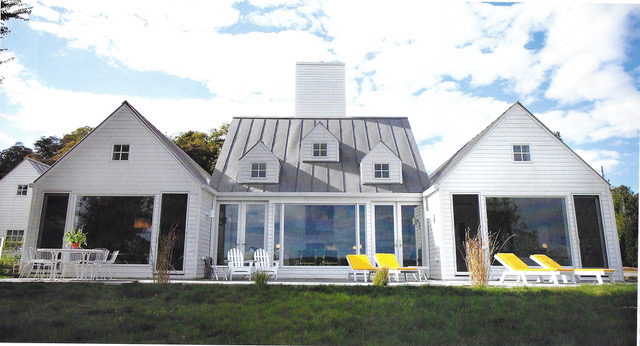by Helen Wilson

September 2020
Even new houses can have a history, and the Weiss house on Beechwood Boulevard near the intersection with Rosemont Lane is a prime example.
Before the house was built, old maps and aerial photographs indicate the land on which it is located was never developed. The tract lay adjacent to the old Squirrel Hill Nursery, which first appears on a 1939 plat map. Before that, the series of landowners who owned the land didn’t sell it to developers to divide up into small residential lots, as was happening all over Squirrel Hill at the time. The aerial maps after 1939 show slag dumping on the site until dumping ceased in 1972. The land reverted to a tangle of trees, shrubs, and underbrush. In the 1990s, a sign appeared advertising a five-unit townhouse construction. The idea was not acceptable to the neighborhood, zoned for single-family homes, and the plan fell through. Then Lou and Amy Weiss purchased the land and erected a very intriguing house with three distinctive peaks, white siding, and a central chimney.
A few months later the Wall Street Journal, Post-Gazette, Shady Ave magazine, and other news media began to run articles about the house. They raved about its clean design by a famous architect, its green features and its great view. Pictures of the exterior showed what can’t be seen from Beechwood Boulevard—walls of glass on the other side of the house, giving an expansive view of the vast Monongahela River valley.
The owner of the house, Lou Weiss, was interviewed about how the house came into being. He said he had found the plans in Life magazine’s “Dream House” series in 1998 in which the magazine asked architects to design the perfect house. The Weisses chose a design by architect Hugh Newell Jacobsen and then proceeded to make changes that would make the house eligible for a LEED (Leadership in Energy and Environmental Design) Platinum certification. They wanted the house to be “light upon the land.”
Lou said the hardwood floors came from sustainable forests, the counters were recycled glass, and the water system included an underground cistern that was used to flush toilets and water the garden. A bit more tweaking would make the water drinkable. The kitchen backsplash came from recycled aluminum from airplane fuselages. The front walkway was made of Pennsylvania bluestones slabs. LEED points were given for building materials that came from within 500 miles. The shrubs and trees the Weisses planted on the back hillside were native species, and the lawn was a special fescue that stayed low and needed only occasional mowing.
Mr. Weiss related the house to its location in a wonderful and thought-provoking way. He said he sited his house there because he wanted to look out over the Monongahela River valley and see where important events in history had taken place. He pointed to where General Braddock met his defeat in 1755 and talked about George Washington getting bullets through his coat but escaping uninjured. He pointed to where the Homestead Steel Strike of 1892 played out across the river. He recalled growing up on Beechwood Boulevard a few blocks away when the massive U.S. Steel mills filled the view. Now he had returned to build his dream home after the mills were gone.


Sources
Johnson, Nancy Polinsky. “Rising to the Challenge.” Shady Ave, Summer 2013.
Sheridan, Patricia. “Their own green acres.” Pittsburgh Post-Gazette, October 14, 2011.
Wilson, Helen. Conversation with Lou and Amy Weiss on CMU Osher tour of the house around 2013.